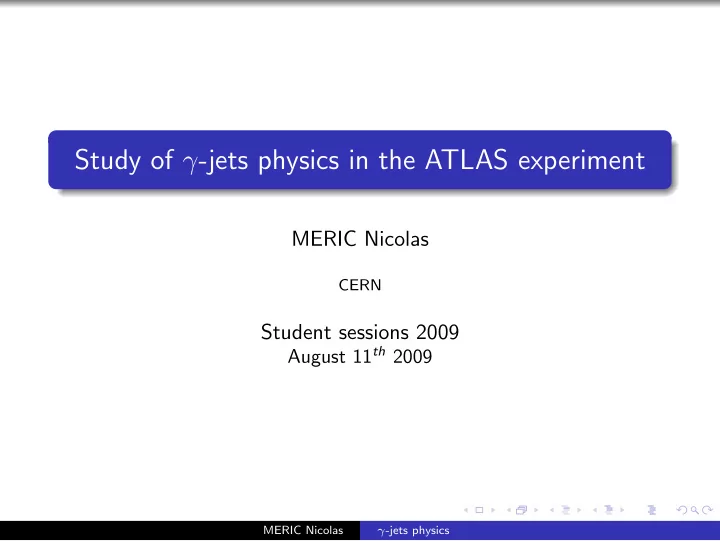

Study of γ -jets physics in the ATLAS experiment MERIC Nicolas CERN Student sessions 2009 August 11 th 2009 MERIC Nicolas γ -jets physics
Why this study? Necessary for backgrounds rejection γ -jets events : half of the background in the H → γγ decay’s channel Should help us to select only the right γγ emission to find the higgs Promising tool for quick and dirty jet calibration MERIC Nicolas γ -jets physics
What is a jet? Hard scattering processes with hadrons ⇒ outgoing partons (i.e. quarks and gluons) They can’t remain as free partons (colour confinement) They will quickly ’fragment’ into hadrons with a complex substructure (hadronization) We see only colour neutral particles (charged or not) with the same kinematics properties than the free partons But jets are actually meaningless without a precise definition ⇒ jets algorithms MERIC Nicolas γ -jets physics
How to define a jet? Cluster algorithm Cone algorithm Theoretical and experimental requirements Theoretical requirements Experimental requirements high speed Infrared safety pile-up resistant small sensitivity to Collinear safety underlying event flexibility ability to resolve the jet’s sub-structure MERIC Nicolas γ -jets physics .
Jet shape analysis Jet shape is a useful tool to Study with the ATLAS cone derive out of cone energy algorithm (radius=0.7) correction get information about the nature of the jet have soft physics under control check Monte-Carlo description of datas the integral allows us to check jet calibration jet energy scale algorithm performances underlying event rejection MERIC Nicolas γ -jets physics
Jet shape analysis We can estimate the contribution of the underlying event, looking at the transverse region This distribution should be better understood and we have to focus to the underlying event to do the correct estimation. MERIC Nicolas γ -jets physics
Underlying event analysis What do we get? Jets What is the underlying event? Hard scattered partons Final state radiation + hadronization Underlying event Initial state radiation Beam-beam remnants Multiple partons interaction + hadronization MERIC Nicolas γ -jets physics
Underlying event analysis What do we see? Underlying event distribution in η = − ln(tan( θ 2 )) Underlying event’s shapes at detector level This curve is a useful tool to get an accurate estimation of the calorimeters response We have an estimation of the underlying event that we can use to calibrate jets at detector level at particle level We need to use this curve with those above to get the calorimeter response We have an estimation of UE at particle level useful to get the right jet energy scale MERIC Nicolas γ -jets physics
What’s next? We are waiting for the first LHC datas The measure of the underlying event will be the first measurement which will be proceed We will have to compare this results with the real one to check the validity of models We are expecting surprises (soft physics can become hard at LHC) MERIC Nicolas γ -jets physics
Recommend
More recommend